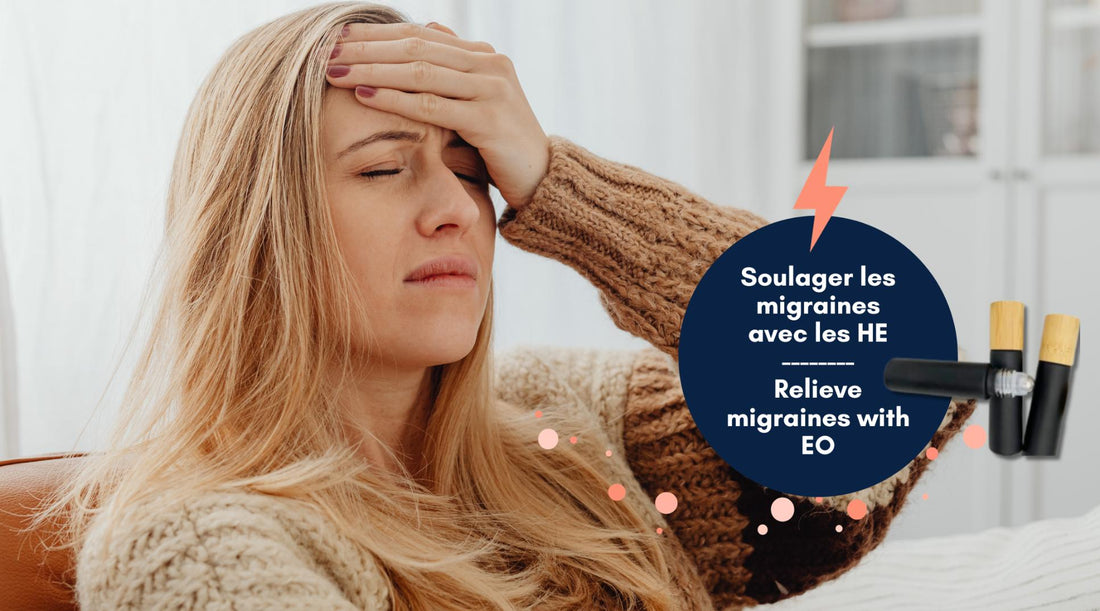
Relieving migraines with essential oils: a natural approach
Share
Migraines, often intense and debilitating headaches, affect many people around the world. Faced with the search for more natural and less invasive solutions, aromatherapy and the use of essential oils are gaining popularity. In this article, we will explore how certain essential oils, supported by scientific studies, can offer relief in the management of migraines.
Warning
Before diving into the benefits of essential oils, it is crucial to emphasize that the information provided here is not a substitute for professional medical advice. Migraines can be a symptom of more serious underlying conditions, and it is therefore imperative to seek medical attention if you suffer from chronic or severe migraines.
The effectiveness of essential oils against migraines
Recent studies have highlighted the effectiveness of certain essential oils in relieving migraines. For example, a 2016 study ( https://pubmed.ncbi.nlm.nih.gov/27106030/ ) found that Peppermint essential oil can specifically target the pathophysiology of headaches. This study suggests that Peppermint oil is a promising choice for migraine relief in adults and children over 6 years old.
Similarly, 2019 research ( https://pubmed.ncbi.nlm.nih.gov/31404204/ ) explored the beneficial effects of aromatherapy on reducing migraine frequency , reinforcing the idea that oils essentials can play a significant role in the management of this condition.
Interestingly, a study published in 2012 ( https://pubmed.ncbi.nlm.nih.gov/22517298/ ) examined the effect of Lavender essential oil in relieving migraines. The results of this study suggested that inhaling lavender oil during a migraine attack could significantly reduce the severity of migraine symptoms.
Another study ( https://pubmed.ncbi.nlm.nih.gov/32155616/ ) explored the effects of Basil essential oil on migraines . This research indicated that the use of basil oil may be associated with a reduction in the severity and frequency of migraine attacks. The results suggest that basil oil, with its analgesic and anti-inflammatory properties, could be a promising option for people suffering from frequent migraines.
These findings highlight the potential of essential oils, such as Peppermint and Lavender, as adjuncts to traditional migraine treatments.

Creating your essential oil applicator
Here's how to create an essential oil applicator to help relieve your migraines:
What you will need
- An empty bottle with roll-on applicator
- Fractionated coconut oil
- 7 drops of Peppermint essential oil
- 7 drops of lavender essential oil
- 7 drops of Basil essential oil
Instructions
- Fill your bottle halfway with fractionated coconut oil.
- Add 7 drops of Peppermint essential oil, 7 drops of Lavender essential oil and 7 drops of Basil essential oil
- Fill the rest of the bottle with the fractionated coconut oil.
- Screw the roll-on applicator onto the bottle and shake gently to mix the oils.
How to use your applicator
At the first feeling of migraine, gently roll the applicator over your temples, forehead and behind the ears. Breathe deeply to enjoy the soothing aromas of essential oils.
Remember that every person is different and what works for one may not work for another. It is important to listen to your body and consult a health professional if necessary.
Age Precautions and Skin Test
It is important to note that the use of essential oils should be appropriate for the age of the user. According to the 2016 study on Peppermint oil ( https://pubmed.ncbi.nlm.nih.gov/27106030/ ), this oil can be used in adults and children over 6 years old. For children under 6 years old and pregnant women, it is advisable to consult a health professional before using essential oils.
Before applying any essential oil, it is also crucial to perform a skin test to ensure there is no allergic reaction. Apply a small amount of the mixture to a small area of skin, such as the inside of the wrist, and wait 24 hours. If no reaction (redness, itching, irritation) is observed, then it is generally safe to use the oil.
Conclusion
Essential oils, particularly peppermint and lavender, offer a promising natural method for relieving migraines. These oils, supported by scientific studies, can be a useful complement to traditional treatments, especially when used with caution and under the supervision of a healthcare professional. However, it is essential to remember that essential oils are not a substitute for professional medical advice and should not be used as the exclusive treatment for chronic or severe migraines. Ultimately, the safest approach is to listen to your body and seek medical attention if you have any doubts or persistent symptoms. Giving this natural approach a chance can be beneficial, but safety and well-being should always come first.
References :
- Göbel H, Schmidt G, Dworschak M, Stolze H, Heuss D. “Effectiveness of Oleum menthae piperitae and paracetamol in therapy of headache of the tension type.” Nervenarzt. 1996 Aug;67(8):672-81. Available at: PubMed .
- Göbel H, Fresenius J, Heinze A, Dworschak M, Soyka D. “Effect of peppermint and eucalyptus oil preparations on neurophysiological and experimental algesimetric headache parameters.” Cephalalgia. 1994 Jun;14(3):228-34; discussion 182. Available at: PubMed .
- Sasannejad P, Saeedi M, Shoeibi A, Gorji A, Abbasi M, Foroughipour M. “Lavender essential oil in the treatment of migraine headache: a placebo-controlled clinical trial.” Eur Neurol. 2012;67(5):288-91. doi:10.1159/000335249. Epub 2012 Apr 17. Available on: PubMed .
- Schattner P, Randerson D. “Peppermint oil does not relieve the pain of irritable bowel syndrome.” Br J Clin Pract. 1996 Jul-Aug;50(6):313-4. Available at: PubMed .
